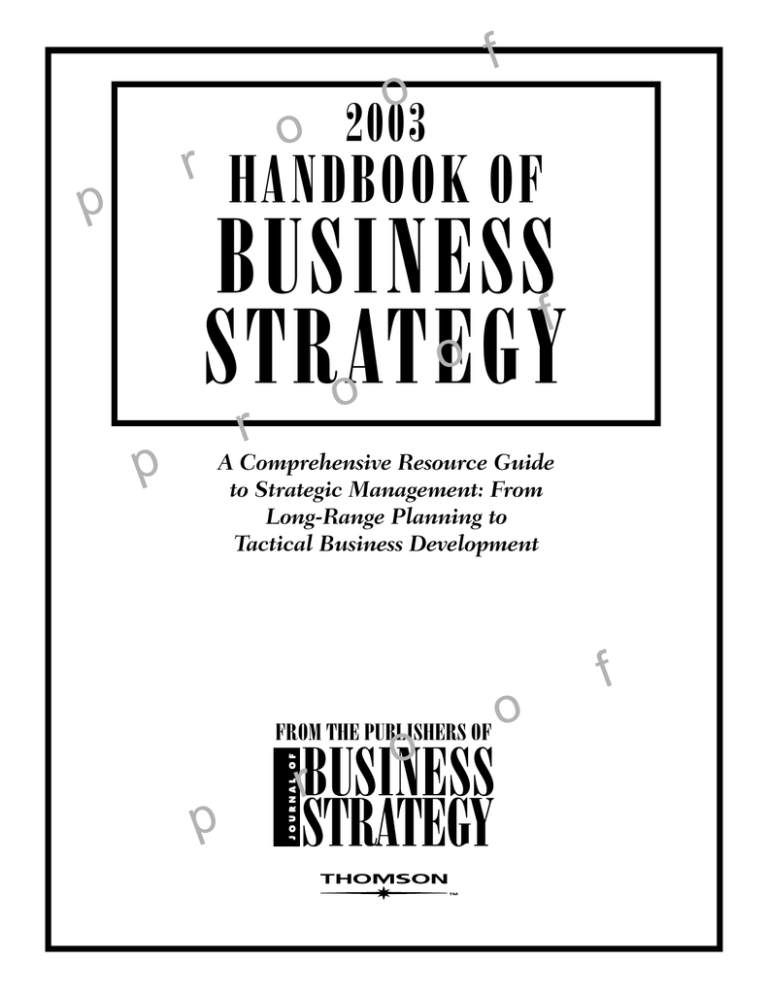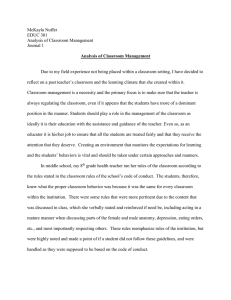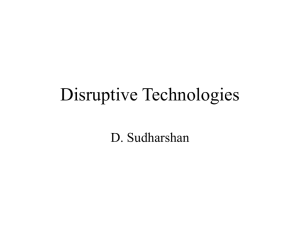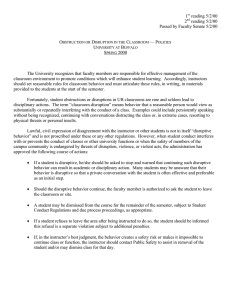BUSINESS STRATEGY HANDBOOK OF 2003
advertisement

o o 2003 r p f HANDBOOK OF BUSINESSf o STRATEGY o p r A Comprehensive Resource Guide to Strategic Management: From Long-Range Planning to Tactical Business Development FROM THE PUBLISHERS OF p r o o f f o o Building an r p Innovation Engine DARRELL K. RIGBY p Here’s a three-part blueprint for building processes for innovation— disruptive innovation— into your organization. p Darrell K. Rigby is a director of Bain & Company, based in the Boston office. He is the founder of Bain’s management tools survey. r f o o hink “innovation” and chances are you think start-up business before you think Fortune 500 organization. Conventional wisdom says large companies are too bureaucratic, too invested in the status quo, and too focused on the next quarter’s numbers to do more than tweak a new product once in a while. A visit to the labs at Johnson & Johnson would help you see things differently. Large organizations can innovate—and even disrupt entire markets—if they take the right approach. A case in point: Early in 2002, J&J won approval to launch its coated stents in Europe. The regulatory signoff sees J&J first to market in a category that it created by combining pharmaceutical and medicaldevice technologies. Industry observers expect the new products to reshape the fast-growing market for stents (the tiny wire tubes that keep blood vessels open after balloon angioplasty) as surely as the minivan reshaped the automotive business. Some analysts figure the new stents, whose coating of special drugs stops scarlike tissue from growing back after surgery, will bring J&J more than $1 billion in annualized sales by the end of 2003. J&J is an unusually successful innovator. But it’s also rare. While most businesses agree innovation can drive growth, few know how to innovate successfully and repeatedly. Those that point proudly to well-funded labs and new product streams are usually pointing to “sustaining innovations”—satisfying existing customers by improving the performance of, say, an car engine or a software application. Truly disruptive innovations—drastically cheaper, simpler innovations that woo new users and create new markets—are much more elusive. They often make enemies of managers who view them as threats to current products. Innovators like J&J succeed by relying on systems, not serendipity. They build enduring “innovation engines.” And far from viewing innovation through not-invented-here lenses, they T r o o f o display a willingness to traffic in new ideas using a discipline called “open-market innovation.” In his1997 bestseller, The Innovator’s Dilemma: When New Technologies Cause Great Firms to Fail, Harvard professor Clayton Christensen noted that time and again, incumbents failed to see disruptions coming until it was too late. The telegraph radically altered the speed and scale of communications, eliminating other sectors, like the Pony Express. Metal welding bashed the riveting trade. Overnight-package delivery hurt postal systems worldwide. Disruptive innovations have huge upside (if you catch them) and downside (if you don’t, but someone else does.) Today, managers may know they need to innovate aggressively, but they pose three reasons for not doing so: 1. Turbulent economic conditions put the focus on cutting costs; 2. The very public failures of potential disrupters—think Internet startups—make innovation seem less urgent; and 3. It’s hard to make a decent return when disruptions are so hard to implement. As one top executive said recently, “I’m a firm believer in the disruption concepts, but I’m increasingly skeptical that our company can implement them.” How, practically, can companies get beyond the skepticism? Bain & Company’s research points to the following three-part blueprint for building disruptive-innovation processes into your organization. r p p 1. MATCH YOUR RESPONSE TO DISRUPTION REALITIES In some industries, businesses believe they face so few disruptive threats that they don’t need to worry. If waves of new products aren’t typical of your industry, you might assume disruption will never happen to you. Steel companies might have argued similarly—before minimills came along. Some industries do face few disruptions. Others are so prone that building an innovation engine should be their highest priority. So how do you know where you stand? Bain’s analysis reveals that disruptive threats to most businesses don’t usually come along every year. They happen once every few years in very dynamic markets, and every few decades in stable ones. Contrast the computer business, in which big changes such as the laptop p o Many companies try to make the technology too elegant. or Dell’s direct build-to-order process have come along every four or five years, with the retail sector, where the cycle is decades long. (See Figure 1) But the disruption sensitivity of an industry can and does change. If a disruptive freight train is suddenly barreling your way, it’s better to take action than to explain why the odds of sleeping on the tracks once seemed so favorable. How can you tell if a train is coming? Start with a thorough analysis of your industry’s sensitivity to disruption. A first step is a scan of the big external factors that can let in big disrupters. (For instance, the development of the interstate freeway system literally paved the way for large suburban discount stores—and hurt city department stores.) Your research then analyzes what your rivals are up to, and monitors the funding going to potentially competitive start-ups (some of which could, by the tenets of open-market innovation, become your acquisition candidates one day). The next step is to match the resulting shortlist against the following six common characteristics of disruptive innovations mapped by Harvard’s Christensen. Disruptive innovations: • Reshape the prevailing business model to earn profits in a new way. Priceline’s online airlineticketing service is an example. • Enable customers to do things only specialists could do before. Charles Schwab made stock trading affordable and accessible for all. • Find their first commercial footing in new, simple, undemanding applications, usually among those not identified previously as customers. Southwest Airlines soared by focusing solely on leisure travelers in short-hop runs. • Tend to migrate upmarket. The Palm handheld computer quickly spawned sophisticated models with much higher price tags. • Don’t disrupt customers—just competitors. r f o o r f o o f f Success doesn’t mean Figure 1. Disruptive Innovations Over the Past 20 Years convincing customers they need to get some4 thing done that they weren’t already trying to 2 get done—it means giv0 ing them ways to get those things done more [Caption] Disruptive innovations over the past 20 years. simply and conveniently. Source: Bain & Company, Inc. Fast food is an example. • Compete differently. Your competitive posture must change as the market changes and customers’ expectations shift. Christensen describes the need to “align with the prevailing basis of competition.” It building a disruptive-innovation engine should go works like this: When a product isn’t yet good to the top of the company’s priorities. Such assessenough, disrupters launch products with higher ments happen periodically at many companies performance or more features. As the products’ with strong innovation records—and regularly at performance begins to equalize, disrupters start exemplary innovators such as J&J. offering greater reliability or quality of service. (Branding is critical here: Even though Intel’s 2. ASSEMBLE THE “INNOVATION ENGINE” microprocessors outpace what mainstream users can harness, the “Intel Inside” brand assures cusThe assembly instructions of an “innovation tomers they should pay a premium.) Then when engine” break into three parts: there’s parity across the marketplace again, conveGather “component” ideas. The keystone step nience becomes the new differentiator. The last is a process that captures and tests a broad range competitive wave: price. of disruptive innovation ideas. Companies that Timing is everything: Many companies have lose the most money on disruptive innovation genmistakenly tried to get a jump on disruption by erally do so not by investing in too many innovaoffering, say, convenience when their customers tions, but by seizing one grand idea, betting irrastill want more product features. They soon learn tionally on its colossal and immediate success, that customers won’t alter their buying behavior— then overengineering it to meet unrealistic expeccannot be disrupted—until they’ve been “overtations. As the saying goes, “Nothing is more danserved” along the existing basis of competition. J&J gerous than an idea when it is the only one you is competing differently by combining pharmaceuhave.” Successful disruption engines are built from tical disciplines with medical-device technology to robust portfolios of disruption devices. Some prove make its coated stents. futile, but others are unstoppable. If you see no history of disruption in your indusHere’s where the open-market discipline really try, no overserved sector, no evidence of competikicks in. You should view your entire business nettors using those six characteristics, and no sign of work as an innovation search party. Your employfunding that could point start-ups your way, it may ees have to know that the culture rewards great be wise to minimize investments in disruptive ideas. Some of the best ideas come from the ranks, innovation. But if you conclude the six characterisbut they are easily killed there. So you must prove tics are becoming common competitive dynamics, that nothing bad happens to those who float lessor they happen to be aligning right now, then than-disruptive concepts. o r p p r f o o r p o o o f f o THE CEO’S ROLE o Should your chief executive be your “chief innovation officer?” Teradyne’s experience supports it. Teradyne makes equipment for testing dense semiconductor chips. In 1995, Alex d’Arbeloff, founder and then-chief executive, was pleased with his firm’s leadership, but he smelled trouble. Some of his testers were as complex and costly as mainframe computers—up to $3 million each. D’Arbeloff knew powerful new chips and software were about to rewrite the rules of the tester business; Teradyne was already studying the idea of a small tester that would use the new technology to do the job of the big machines at a quarter of the price. D’Arbeloff knew too that rivals were thinking the same way. Here are the principles he followed to “out-innovate” them: Assess the industry’s “disruptability.” D’Arbeloff had plenty of experience in the mainframe computer business, and he’d seen what had happened there when the minicomputer came along. He knew someone would one day crack the code on the scaled-down tester. Begin innovating in a “safe” area. After committing to the small tester project, d’Arbeloff began to look inside for managers to run it. Each of his five divisional chiefs acknowledged the importance of the project, but each objected to taking it on. None wanted to take staff off existing work. D’Arbeloff saw the venture had to be set up and staffed separately. He appointed a senior quality manager as project director, and in April 1995, launched the project, code-named Aurora. Educate to innovate. D’Arbeloff began the education process quietly—a chat with this general manager, lunch with that vice president. Was the new con- cept for real? What was the competition up to? Would Aurora cannibalize the big tester business? Later, d’Arbeloff pulled in his top lieutenants to “talk disruption.” One of those meetings hosted Harvard Business School professor Clayton Christensen, author of a January 1995 Harvard Business Review article on disruptive innovation that most of the Teradyne executives had read. The disruption idea began to catch on. Balance disruptive and core activities. At one point, d’Arbeloff’s constant involvement—detailed discussions with the project leader several times a week—made all the difference. When his project chief began to recruit, the buzz around Aurora threatened to start a stampede of talent out of the core business. Straddling mainstream and disruptive activities—viewing disruption in context of the overall business—the CEO was able to step in to set limits. Plan to profit. Aurora didn’t have to hit operating goals such as sales projections, but it still had to stick to tight cost controls. The temptation was always to reach for the stars, but d’Arbeloff kept the project focused: It began by specializing in testing microcontroller chips. D’Arbeloff and the board had to push repeatedly to keep Aurora simple and low cost. He looked for early results too, and got them: Within 18 months of its April 1998 debut, Aurora testers hit annualized revenues of $150 million— Teradyne’s fastest sales ramp ever. Also, Aurora technology began to enrich Teradyne’s big tester designs—crossover that owed much to d’Arbeloff’s early work to get his senior managers to understand the problems with the status quo and the promise of betting on Aurora. Your innovation search parties should look in three directions: inside the organization (many of Sony’s homegrown products—the transistor radio, for instance—created classic disruptions); among business partners, customers, and suppliers (Intel got its start in microprocessors when it accepted an order from Busicom, a second-tier Japanese calculator company); and toward competitors— particularly start-ups. Johnson & Johnson has excelled in two of those search directions. The company regularly supple- ments its organic innovation by launching products of disruptive technologies through small companies acquired for that purpose. Its Definity 2 progressive contact lens came from innovations conceived by an optometrist whose technology firm J&J purchased in 1997. And the Ethicon stitching unit, scanning the industry for disruptions, identified a potential threat from Closure Medical Corp., whose Dermabond tissue adhesive was challenging stitches as the main method of suturing wounds. Risking the loss of its 80 per- r p o r p p r f o o o f o o cent share of the worldwide suture market, Ethicon invited Closure Medical into a partnership from which the J&J unit then marketed and promoted the Food and Drug Administrationapproved technology. Absent guidelines, though, idea capture will be haphazard at best, and testing of ideas won’t have a chance. How does your Pacific Northwest sales manager get a fair hearing for the killer product a major customer has just described? It’s one thing to encourage a flow of constructive ideas, but it’s another to educate the organization to break built-in resistance to disruptions when a new venture is so threatening to incumbent interests. And it’s yet another thing to signal that innovation is becoming a strategic lynchpin. If your organization’s most senior managers aren’t exposed to the concept of disruption and don’t understand its long-term role in creating value for the whole organization, they probably won’t agree to do things that run counter to the dominant processes or values of the mainstream businesses. Education can begin with informal tactics, with distribution of articles on innovation from key business publications, or brown-bag lunches where invited speakers describe how their organizations innovated successfully. Later, it can begin to form a language of disruption, using distinct vocabulary and terms on internal Web sites and employee newsletters to help shape an innovation culture. At Intel, disruptive innovation has become a key topic on the corporate training agenda. Send the right ideas to the right work areas. Now you need to sort your collection of ideas and assign them to organizational units for implementation. Scrap low-priority ideas. Send sustaining innovations to the operating units where they will align well with the prevailing values, and where their chances of success are much greater. (Be careful to view the innovation in context: The same innovation may be disruptive in one organization, but sustaining in another. The Internet was disruptive to Compaq Computer but not to Dell Computer, which saw it as a way to complement its direct selling by phone and fax.) But the truly disruptive ideas must always go to “safe” independent work areas. There, they can develop without intervention from managers who fear their products will be “cannibalized” by the r p o r p p r f Change your competitive posture as the market changes. f new approach. The nursery approach is critical because very few organizations are set up to “selfdisrupt.” A company can’t assemble an innovation engine unless disrupters recognize that their nonconformist initiatives, by definition, will run headlong into three organizational buzz saws: resource capabilities (including tangibles like equipment, cash, people, and technologies, and less tangible ones like information, brands, and product designs); processes (the patterns of interaction, communication, decision making, and coordination that employees use to transform resources into products and services of greater worth); and values (the criteria by which companies set priorities). Successfully disrupting those most fundamental dimensions requires far more energy and time than the average implementer understands. In fact, the greatest barriers to disruptive innovations are frequently organizational ones. For instance, Compaq’s attempt to launch an online catalog failed. Resistance from its established retail channel was so fierce that the company had to nix the effort. Harvard’s Christensen observes that Compaq’s processes and values weren’t compatible with those required to successfully launch an Internet business at that point. Had Apple Computer followed the guideline of a separate organization for truly disruptive ideas, perhaps it would not have been embarrassed by its $350 million misstep with the Newton handheld computer. Apple attempted to force-fit the Newton into its computer model—trying to make a handheld good enough to be used as a computer. Meanwhile, start-up Palm Computing, launched to build software for handheld computers, saw a golden opportunity for a simpler product. Unfettered by existing processes and values, and with o o o f fresh and dedicated resources, the Palm team was able to launch an entirely new product category. Plan to profit. Disruptive innovation should not cost a fortune; it should quickly self-fund. Once approved, a disruptive project’s ability to produce quick wins—ideally, to generate profits from the get-go—is key to its long-term survival. Early wins open the way for larger projects that target larger markets, and leave a trail of metrics that telegraph success. Planning for quick profits creates three important advantages: It keeps disruption development as simple as possible—few bells, no whistles— which increases the probability of success. It uses a bulletproof business plan so the venture is robust enough to weather everything from economic downturns to leadership transitions. And lower investment per project lets the company pursue more disruptive innovations without diluting earnings. Again, the probability of success rises. Yet many companies try to make the technology too elegant. There are myriad examples of overinvesting in innovation: Failed online grocer Webvan is perhaps the most outrageous, and Preston Tucker’s Torpedo automobile, which in 1948 came with seat belts and shatterproof glass long before customers were ready for such safety measures, is arguably the most notorious. But what is it that pushes innovation projects to excess? Analysis suggest that project champions, presenting to senior management, feel forced to demonstrate that their maverick initiatives will get big enough fast enough to satisfy the company’s growth needs. The sequence of steps for building an innovation engine is not diecast. As the confluences of resources, values, and processes vary from one organization to another, so will their innovationengine blueprints. What is important is that there is a blueprint, and that it is designed around the organizational principles outlined. o r p o r p 3. KEEP THE ENGINE RUNNING You may have assembled a powerful innovation engine, but will it run reliably for a long time? The actions taken after one successful disruption are critical to the likelihood of another. Five practices are associated with profitable perpetuation of disruption: p r f Intel, disruptive oAtinnovation has become a key topic on the training agenda. Think small. Johnson & Johnson is one of the few organizations that have found ways to consistently innovate despite its complexity and scale. (J&J has $29 billion in revenues and 99,000 employees across 195 operating units.) Emphasizing the decentralized approach that enables disruption and quick decision making, J&J pitches potential recruits under the banner of “small-company environment, big-company impact.” Think wide. Increasingly, businesses are searching outside their own four walls for the ideas they need. A growing number of companies have begun moving toward open-market innovation—an approach that brings the benefits of free trade to the flow of new ideas. By systematically opening their innovation borders to vendors, customers, and even competitors, they are increasing the imports and exports of novel ideas. As they do, they improve the speed, cost, and quality of innovation. Share the wealth and the wisdom. Just because disruptive innovations should be incubated in an independent environment doesn’t mean they should stay there forever. As a disruptive innovation matures, there will be more opportunities to share activities with other parts of the organization. In fact, you should share the rewards to encourage cooperation on future disruptive initiatives. Managers should already be thinking three years ahead when asking questions such as: • Which activities will be shared with other parts of the organization? • Should we transfer managers to and from disruptive businesses to strengthen their general management skills and teamwork? • How might we involve the heads of disruptive businesses in traditional planning processes to encourage more aggressive innovation? Your organization should also start to tap into f o o o f the innovation “infrastructure”: the funding sources (such as venture capital), the intellectualproperty law firms, the underwriter community, and the government bodies that oversee intellectual-property rights. Attract mavericks. In their early days, disruptive innovations thrive with maverick leaders. At one electronic equipment maker, executives emphasize the importance of staffing their innovation efforts only with the kinds of managers labeled “responsibly disobedient.” They’re the ones who are ready for and energized by a new mission; they balance ego with self-confidence; and they rapidly apply adaptive skills and “no-permission” actions to see the mission through. Your human resources operation should begin to develop processes for locating and hiring such individuals (from outside your organization as well as inside), and for moving selected employees into and out of your disruptive projects. Market your success. Get busy spreading success stories. The key messages need to reach multiple audiences—employees, potential recruits, clients, prospects, investors, alliance partners—via o r p o r p p r f o The greatest barriers to disruptive innovations are organizational ones. multiple channels. Generally, disruption champions are pretty good at sharing what they learn; they know that by publicly celebrating successes, they create a virtuous circle of widening support for the innovation engine. Although most executives recognize that disruptive innovation has strategic value, few know how to make it an inseparable part of their business activities. By tuning the values of the organization to embrace disruptive innovation, and building processes and allocating resources to support it over the long term, businesses in many sectors can make disruptive innovation profitable—and repeatable. ● f o o o f



